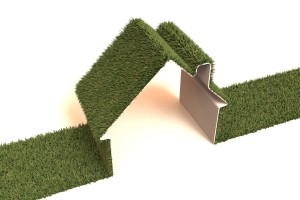
Green Design: Plans with simple exterior walls with fewer corners, bays and protrusions use less construction materials. Smaller homes use less energy for heating and cooling and require fewer resources to build and maintain.
Floor plans that can accommodate later expansion will eliminate the need to move as your household changes. If the master bedroom is on the first floor, the house may be more livable as you age. Large walls and windows can take advantage of passive solar heating. Well designed roof overheads can provide shade.
Green Materials: You can choose recycled or sustainable materials in the construction of the home. Roofing materials made of recycled materials are popular. Tiles made of recycled rubber, plastic or wood fiber are available. Some products come from clean, re-used materials from homes, others from post-industrial factory waste. These recycled materials can be amazingly durable and attractive. Slate and clay tiles can last hundreds of years. These are made of natural earthen materials that do not pollute or dilute natural elements. Recycled slate tiles are available as well. Metal roofing is at least partially recyclable. Metal tiles are exceptionally durable and fire-resistant. Metal roofing is ideal for water and snow runoff and can be integrated into a drainage system for rainwater collection. Aluminum tiles made largely of recycles beverage cans can resemble wood shakes or slate tiles, in many colors. Reinforced rubber shingles made from discarded steel-be lted tires are available coated with ground slate for texture.
Choices for the Interior:
Insulation is important to reduce heating costs and wasted energy. Insulation materials made of sustainable shredded denim, hemp, or sheep’s wool using less energy to manufacture than conventional fiberglass. Insulating spray foam made of soybean is also available.
The home should be designed with windows carefully set to avoid drafts. Use multi-layered glass in windows and carefully designed doors that block air flow. Choose low flow toilets to reduce water use. Many homes include waterless toilets as well.
For some homes, solar panels can be installed to generate electricity which contributes to the grid. Solar systems can also heat water for use in the home using a fraction of water-heating fuel.
If you are planning to build a new green home, J. Schmidt Homes will help you construct a home with environmentally conscious materials.






Speak Your Mind